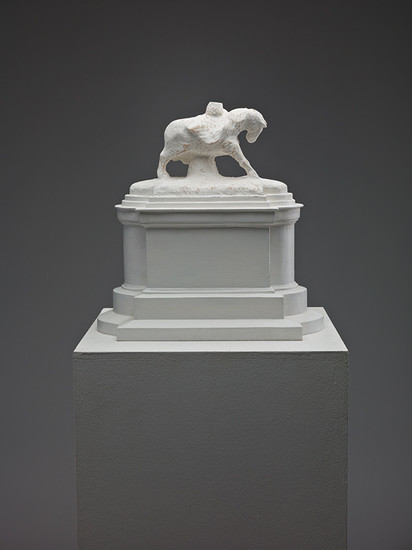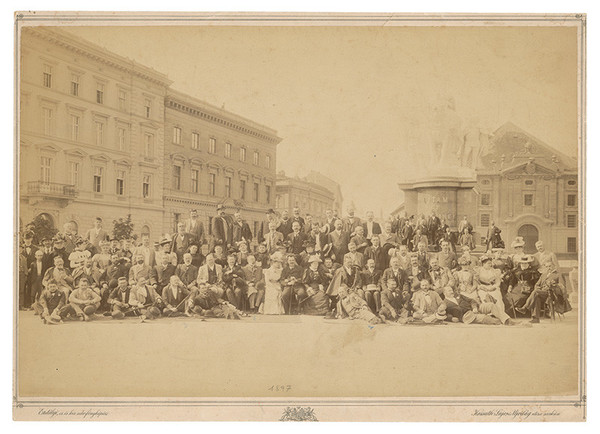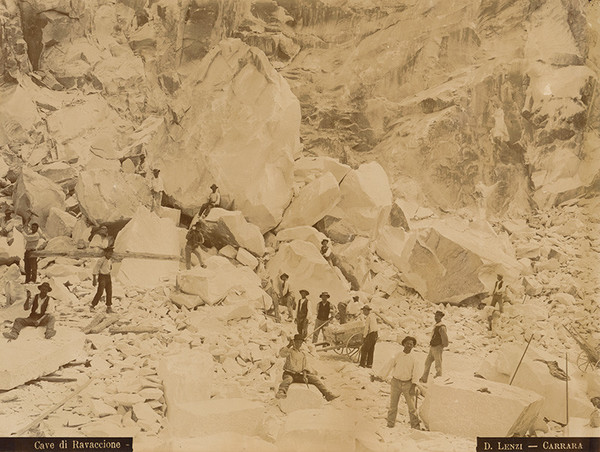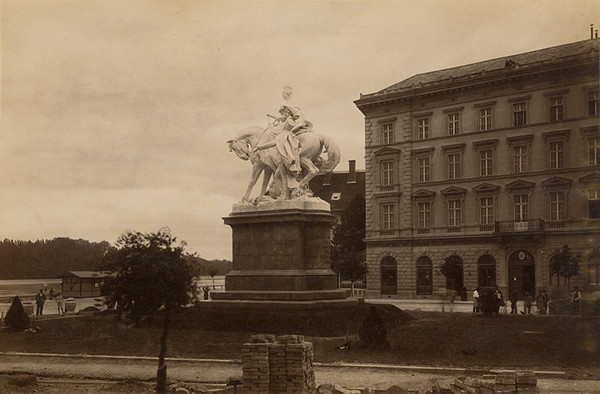Looking at the statue 26 October 1921, destruction of the Maria Theresa monument in Bratislava (2007 - 2019) by contemporary artist Martin Piaček (1972), displayed in the window of Esterházy Palace - it is crucial to realize that we are just a couple of meters away from a place where the monument to Maria Theresa was unveiled in May 1897 and stood until its vandalistic destruction during the First Republic. Its granite pedestal stood there for another four years, without a monumental marble sculpture, silent remorse and a symbol of human vandalism.
To complete the constellation of space and time, let us add that the monument's author, Ján Fadrusz (1858 - 1903), a native of Pressburg, living and working in Budapest, did not live to see his important work being destroyed. He died prematurely at the age of 45, but his portrait bust, presented to him by the people of Pressburg in his honour, had to silently witness the merciless destruction and brutal drama of the demise of an honestly crafted and artistically valuable work. Today, it would undoubtedly be a significant cultural monument and a mandatory stop for tourist guides on their walks around Bratislava.
On today's Ľudovít Štúr Square, the original location of the Coronation Hill, several statues met and lively circulated throughout its past. On the one hand, a memorial to the sculptor Ján Fadrusz [1], his own monumental creation (also referred to as a memorial), currently a monument to Ľudovíť Štúr (by Tibor Bartfay) and before that a monument to M. R. Štefánik (by Bohumil Kafka). We are located on one of Bratislava's squares that was "buzzing" with monuments. The statues changed according to political affairs and social interests, similar to public spaces in every major city. If we thought that monuments and memorials were stable, historically verified, immovable, then we were very wrong. Ever since this sculptural genre originated in history, it has been influenced by the reactions and attitudes of society and had no solid foundations. In one era, the statue is considered proper, yet it can evoke extreme emotions in another. Let us mention the recent and still ongoing removal of sculptures in European and American cities (Black Lives Matter movement). That is why contemporary societies and artists approach the construction of new monuments and memorials with great precision. This classical genre of sculpture has almost disappeared, especially its haughty monumental dimensions. For this very reason, no great sculptural gestures and monumental works are created in such quantity, but unfortunately, neither in quality. In the development of art, it was replaced by other forms of reminders of historical events and personalities (temporary or permanent site-specific installations or architectural solutions). These, we encounter in our country only by exception (for example, Chatam Sofer Memorial in Bratislava by architect Martin Kvasnica or currently non-existing Folk Architecture Monument in Košice by Tomáš Džadoň).
Sculptor Martin Piaček uses several of his works to reflect upon current topics of contemporary art. Themes of reactions, interpretations, critical comments of the memory and especially its brevity, perforation or permeability, in connection with conscious or unconscious forgetting, displacing of unpleasant historical facts or traumas have an important place in his oeuvre. Since 2007, Piaček has been conceiving a well-known and still open cycle - The Greatest Embarrassments of Slovak History (2007 - 2019). He created a series of deliberately anti monumental, subjectively chosen, infamous historical events that can no longer be erased or reversed. He decided to approach their depiction through the traditional genre, referring to the monument and memorial or classical figural sculpture on a chamber scale. He created a series of models of real-life situations in pure white, using the technique of chalked woodcarving, in which the legacy of sculptural plaster as an auxiliary material is clearly present. The author's choice of smaller sculptural models was most likely due to the fact because similar "fails" are rarely depicted and much less celebrated through monumental memorials with ceremonial unveilings - we would rather forget them. Thus they remain work-in-progress versions of non-existent and unfeasible monuments. They are materialized symbols of remorse, painful reminders of gaffes and falls that accompany the historical moments of fame and glory, yet we are often less willing to remember or pay attention to them. In response to the destruction of the monument to Maria Theresa, Piaček also reflects on the history of sculptural art, draws attention to the short life of monuments and the slippery slope of depicting historical events and personalities in time and in public space. The author laments the vandalism of artistic monuments, sculptures from this cycle serving as a memento of historical embarrassments that could be repeated at any time.
Fadrusz's memorial to Maria Theresa belonged to the three of his best monumental works, two of which are preserved in Hungary, but even there, they did not survive unnoticed and without reactions. Martin Piaček displayed the Bratislava monument amid its destruction. The statue represents only a torso of the original sculpture; a horse or a pony with a fragment of a lower part of a seated figure. Ján Fadrusz worked on the monument for several years; he created it from a magnificent piece of Carrara marble. Today, its authentic aesthetic impact is captured only in historical photographs; Fadrusz made it in a historicist style with predominant features of Baroque art. Overall, the majestic monument was tall - it measured up to eleven meters in height, including the pedestal. It depicted the event associated with the coronation of Maria Theresa in 1741. The central figure of the large-scale composition was a queen in coronation attire, sitting on a horse with a gently bowed head, broken cannon and a trampled basket under them and a Kuruc soldier and a nobleman standing on either side [2]. These days we commemorate the 100th anniversary of the destruction of the Fadrusz memorial. A symbol of an oppressive regime, it became a target of a 1921 attack by legionnaires who expressed their hatred for the work of art in the most barbaric way while frightened people of Pressburg looked on. According to the reports in the period press, many of the city's residents could not resist tears and screams as legionnaires guarded by the police destroyed the monument with hammers and other tools. Fadrusz's work, created over several years, was divided into smaller and larger fragments, some of which resulted in different sculptural realizations, others were lost, but as history shows, a certain amount of nostalgia for this masterpiece has been able to persist until today.
The sculptor Martin Piaček generously donated the works from the cycle The Greatest Embarrassments of Slovak History to the collection of the Slovak National Gallery. You can read more about the exhibition and the artwork at www.sng.sk. You can find digital reproductions of other works from the cycle The Greatest Embarrassments of Slovak History by Martin Piaček at www.webumenia.sk/en.
Vladimíra Büngerová
The exhibition cycle of the Slovak National Gallery, In the Shop Display, enters the public space through the window of Café Berlinka on the ground floor of the Esterházy Palace, presenting works of visual art responding to the issues of contemporary life. In this exhibition format, we have revived collaboration between Peter Bartoš and Július Koller, who exhibited their works in a storefront of a stocking repair shop in Klobučnícka Street in Bratislava under the title Interpretation (Anti-gallery).
[1] Portrait bust of sculptor Ján Fadrusz by Ján Pflieger from 1911-1912 is located in the collection of The City Gallery of Bratislava.
[2] Grajciarová, Želmíra: Sochár Ján Fadrusz a Bratislava. Galéria mesta Bratislavy, 1997, p. 35.





